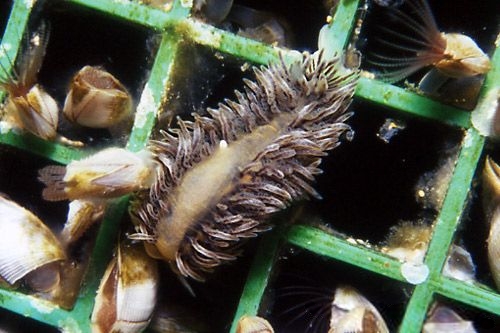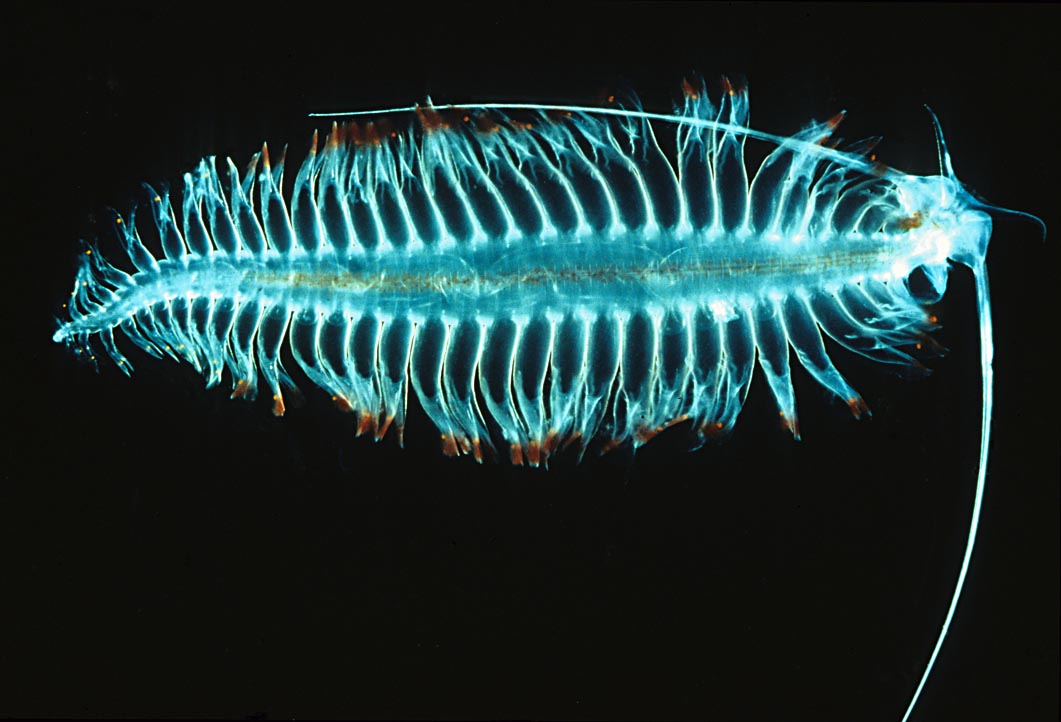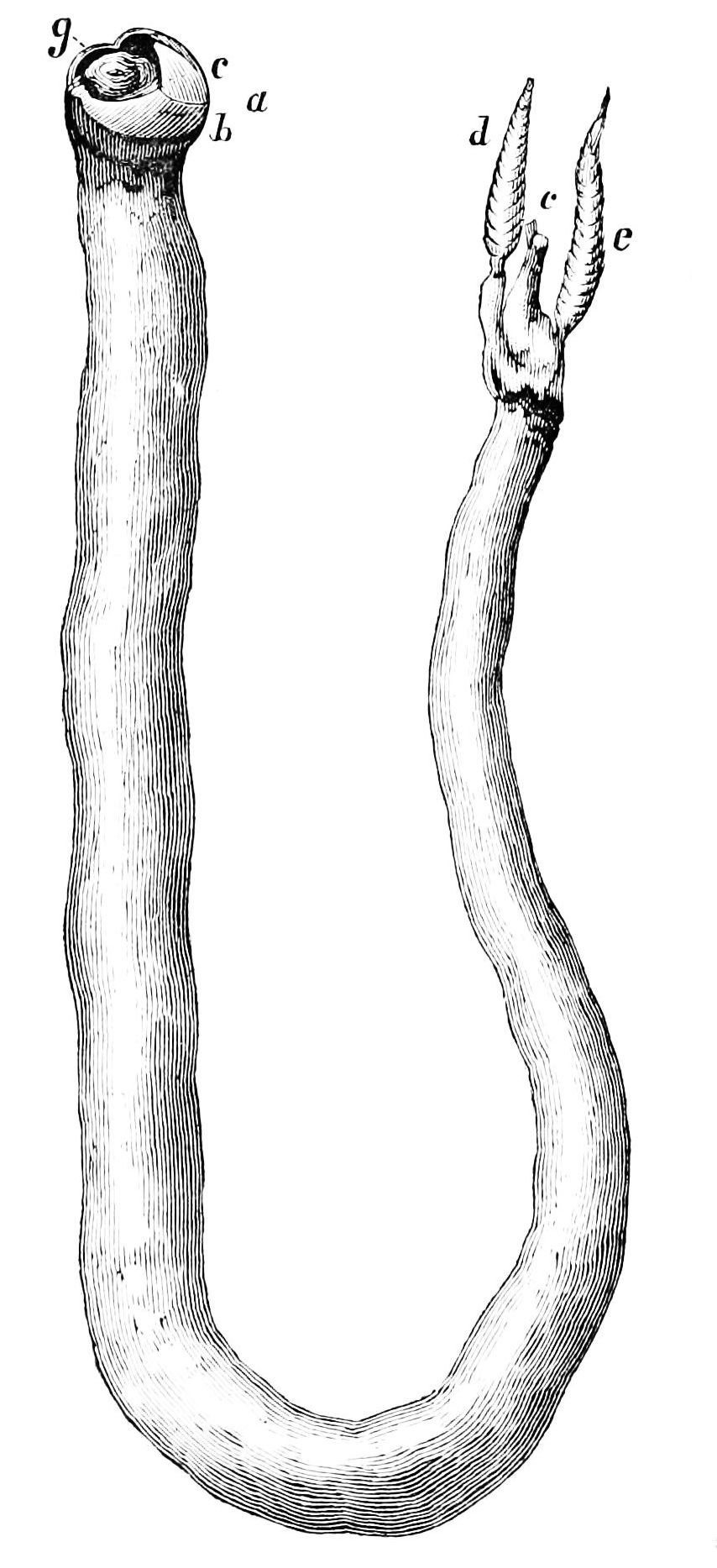|
Veliger
A veliger is the planktonic larva of many kinds of sea snails and freshwater snails, as well as most bivalve molluscs (clams) and tusk shells. Description The veliger is the characteristic larva of the gastropod, bivalve and scaphopod taxonomic classes. It is produced following either the embryonic or trochophore larval stage of development. In bivalves the veliger is sometimes referred to as a D-stage (early in its development) or pediveliger (late in its development) larva. This stage in the life history of these groups is a free-living planktonic organism; this mode of life potentially enhances dispersal to new regions far removed from the adult mollusks that produced the larvae. The general structure of the veliger includes a shell that surrounds the visceral organs of the larva (e.g., digestive tract, much of the nervous system, excretory organs) and a ciliated wikt:velum#English, velum that extends beyond the shell as a single or multi-lobed structure used for swimming ... [...More Info...] [...Related Items...] OR: [Wikipedia] [Google] [Baidu] |
Fiona Pinnata
''Fiona pinnata'', common name Fiona, is a species of small pelagic nudibranch (sea slug), a marine (ocean), marine gastropod mollusk in the superfamily Fionoidea. This nudibranch species lives worldwide on floating objects on seas, and feeds mainly on barnacles, specifically goose barnacles in the genus ''Lepas''. The anatomy of this species is very unusual. It is currently the only named member of the genus ''Fiona'' but a 2016 study showed that this species is a species complex. The family (biology), family Fionidae was expanded in 2016 to include Tergipedidae, Eubranchidae and Calmidae as a result of a molecular phylogenetics study. Features that are characteristic of the genus ''Fiona'' includeWillan R. C. (1979) "New Zealand locality records for the aeolid nudibranch ''Fiona pinnata'' (Eschscholtz)". ''Tane'' 25: PDF/ref> the similar-looking oral tentacles and rhinophores; the cerata with a membrane and lacking a cnidosac; a dorsal anal opening; a Reproductive system of gast ... [...More Info...] [...Related Items...] OR: [Wikipedia] [Google] [Baidu] |
Plankton
Plankton are the diverse collection of organisms that drift in Hydrosphere, water (or atmosphere, air) but are unable to actively propel themselves against ocean current, currents (or wind). The individual organisms constituting plankton are called plankters. In the ocean, they provide a crucial source of food to many small and large aquatic organisms, such as bivalves, fish, and baleen whales. Marine plankton include bacteria, archaea, algae, protozoa, microscopic fungi, and drifting or floating animals that inhabit the saltwater of oceans and the brackish waters of estuaries. fresh water, Freshwater plankton are similar to marine plankton, but are found in lakes and rivers. Mostly, plankton just drift where currents take them, though some, like jellyfish, swim slowly but not fast enough to generally overcome the influence of currents. Although plankton are usually thought of as inhabiting water, there are also airborne versions that live part of their lives drifting in the at ... [...More Info...] [...Related Items...] OR: [Wikipedia] [Google] [Baidu] |
Nudibranch
Nudibranchs () are a group of soft-bodied marine gastropod molluscs, belonging to the order Nudibranchia, that shed their shells after their larval stage. They are noted for their often extraordinary colours and striking forms, and they have been given colourful nicknames to match, such as "clown", "marigold", "splendid", "dancer", "dragon", and "sea rabbit". About 3,000 species of nudibranchs are known.Ocean Portal (2017)A Collage of Nudibranch Colors Smithsonian National Museum of Natural History. Retrieved 17 April 2018. The word ''nudibranch'' comes from the Latin 'naked' and the Ancient Greek () ' gills'. Nudibranchs are often casually called sea slugs, as they are a family of opisthobranchs (sea slugs), within the phylum Mollusca (molluscs), but many sea slugs belong to several taxonomic groups that are not closely related to nudibranchs. A number of these other sea slugs, such as the photosynthetic '' Sacoglossa'' and the colourful Aglajidae, are often confused wi ... [...More Info...] [...Related Items...] OR: [Wikipedia] [Google] [Baidu] |
Gastropod Anatomy
Gastropods (), commonly known as slugs and snails, belong to a large taxonomic class of invertebrates within the phylum Mollusca called Gastropoda (). This class comprises snails and slugs from saltwater, freshwater, and from the land. There are many thousands of species of sea snails and slugs, as well as freshwater snails, freshwater limpets, land snails and slugs. The class Gastropoda is a diverse and highly successful class of mollusks within the phylum Mollusca. It contains a vast total of named species, second only to the insects in overall number. The fossil history of this class goes back to the Late Cambrian. , 721 families of gastropods are known, of which 245 are extinct and appear only in the fossil record, while 476 are currently extant with or without a fossil record. Gastropoda (previously known as univalves and sometimes spelled "Gasteropoda") are a major part of the phylum Mollusca, and are the most highly diversified class in the phylum, with 65,000 to 80, ... [...More Info...] [...Related Items...] OR: [Wikipedia] [Google] [Baidu] |
Dreissena Polymorpha
The zebra mussel (''Dreissena polymorpha'') is a small freshwater mussel, an aquatic bivalve mollusk in the family Dreissenidae. The species originates from the lakes of southern Russia and Ukraine, but has been accidentally introduced to numerous other areas and has become an invasive species in many countries worldwide. Since the 1980s, the species has invaded the Great Lakes, Hudson River, Lake Travis, Finger Lakes, Lake Bonaparte, and Lake Simcoe. The adverse effects of dreissenid mussels on freshwater systems have led to their ranking as one of the world's most invasive aquatic species. The species was first described in 1769 by German zoologist Peter Simon Pallas in the Ural, Volga, and Dnieper Rivers. Zebra mussels get their name from a striped pattern commonly seen on their shells, though it is not universally present. They are usually about the size of a fingernail, but can grow to a maximum length around . Their shells are D-shaped, and attached to the substrate wit ... [...More Info...] [...Related Items...] OR: [Wikipedia] [Google] [Baidu] |
Journal Of Zoology
The ''Journal of Zoology'' is a scientific journal concerning zoology, the study of animals. It was founded in 1830 by the Zoological Society of London and is published by Wiley-Blackwell. It carries original research papers, which are targeted towards general readers. Some of the articles are available via open access, depending on the author's wishes. According to the ''Journal Citation Reports'', the journal has a 2020 impact factor The impact factor (IF) or journal impact factor (JIF) of an academic journal is a type of journal ranking. Journals with higher impact factor values are considered more prestigious or important within their field. The Impact Factor of a journa ... of 2.322, ranking it 36th out of 175 journals in the category "Zoology". From around 1833, it was known as the ''Proceedings of the Zoological Society of London'' (). From 1965 to 1984, it was known as the ''Journal of Zoology: Proceedings of the Zoological Society of London'' (). See also * List ... [...More Info...] [...Related Items...] OR: [Wikipedia] [Google] [Baidu] |
Holoplankton
Holoplankton are organisms that are planktic (they live in the water column and cannot swim against a current) for their entire life cycle. Holoplankton can be contrasted with meroplankton, which are planktic organisms that spend part of their life cycle in the benthic zone. Examples of holoplankton include some diatoms, radiolarians, some dinoflagellates, foraminifera, amphipods, krill, copepods, and salps, as well as some gastropod mollusk species. Holoplankton dwell in the pelagic zone as opposed to the benthic zone. Holoplankton include both phytoplankton and zooplankton and vary in size. The most common plankton are protists. Reproduction Holoplankton have unique traits that make reproduction in the water column possible. Both sexual and asexual reproduction are used depending on the type of plankton. Some invertebrate holoplankton release sperm into the water column which are then taken up by the females for fertilization. Other species release both sperm and egg to i ... [...More Info...] [...Related Items...] OR: [Wikipedia] [Google] [Baidu] |
Trochophore
A trochophore () is a type of free-swimming planktonic marine larva with several bands of cilia. By moving their cilia rapidly, they make a water eddy to control their movement, and to bring their food closer in order to capture it more easily. Occurrence Trochophores exist as a larval form within the trochozoan clade, which include the entoprocta, entoprocts, molluscs, annelids (including echiurans and sipunculans) and nemerteans. Together, these phyla make up part of the Lophotrochozoa; it is possible that trochophore larvae were present in the life cycle of the group's common ancestor. Etymology The term ''trochophore'' derives from the ancient Greek (), meaning "wheel", and () — or () —, meaning 'to bear, to carry', because the larva is bearing a wheel-shaped band of cilia. Feeding habits Trochophore larvae are often planktotrophic; that is, they feed on other plankton species. Life cycle The example of the development of the annelid ''Pomatoceros lamarckii ... [...More Info...] [...Related Items...] OR: [Wikipedia] [Google] [Baidu] |
Prodissoconch
A prodissoconch (meaning first or earliest or original shell) is an embryonic or larval shell which is present in the larva of a bivalve Bivalvia () or bivalves, in previous centuries referred to as the Lamellibranchiata and Pelecypoda, is a class (biology), class of aquatic animal, aquatic molluscs (marine and freshwater) that have laterally compressed soft bodies enclosed b ... mollusk (clams, scallops, oysters, etc.). (The homology (biology), homologous structure in gastropods (snails) is called the protoconch.) The prodissoconch is often but not always smooth, and has no growth lines. It is sometimes still present and visible in the adult shell, if there has been no erosion of the shell in that area. The structure of the prodissoconch has been widely used as a discriminating feature in bivalve systematics. Position Once the larval bivalve settles and becomes a juvenile, the rest of the shell starts to grow. The earliest part of the shell that formed often shows in ... [...More Info...] [...Related Items...] OR: [Wikipedia] [Google] [Baidu] |
Dorsum (biology)
Standard anatomical terms of location are used to describe unambiguously the anatomy of humans and other animals. The terms, typically derived from Latin or Greek roots, describe something in its standard anatomical position. This position provides a definition of what is at the front ("anterior"), behind ("posterior") and so on. As part of defining and describing terms, the body is described through the use of anatomical planes and axes. The meaning of terms that are used can change depending on whether a vertebrate is a biped or a quadruped, due to the difference in the neuraxis, or if an invertebrate is a non-bilaterian. A non-bilaterian has no anterior or posterior surface for example but can still have a descriptor used such as proximal or distal in relation to a body part that is nearest to, or furthest from its middle. International organisations have determined vocabularies that are often used as standards for subdisciplines of anatomy. For example, '' Terminolog ... [...More Info...] [...Related Items...] OR: [Wikipedia] [Google] [Baidu] |
Shipworm
The shipworms, also called teredo worms or simply teredo (, via Latin ), are marine bivalve molluscs in the family Teredinidae, a group of saltwater clams with long, soft, naked bodies. They are notorious for boring into (and commonly eventually destroying) wood that is immersed in seawater, including such structures as wooden piers, docks, and ships; they drill passages by means of a pair of very small shells (" valves") borne at one end, with which they rasp their way through. They are sometimes called "termites of the sea". Carl Linnaeus assigned the common name '' Teredo'' to the best-known genus of shipworms in the 10th edition of his taxonomic ''magnum opus'', '' Systema Naturæ'' (1758). Characteristics Removed from its burrow, the fully grown teredo ranges from several centimeters to about a meter in length, depending on the species. An average adult shipworm measures in length and less than in diameter, but some species grow to considerable size. The body is c ... [...More Info...] [...Related Items...] OR: [Wikipedia] [Google] [Baidu] |








